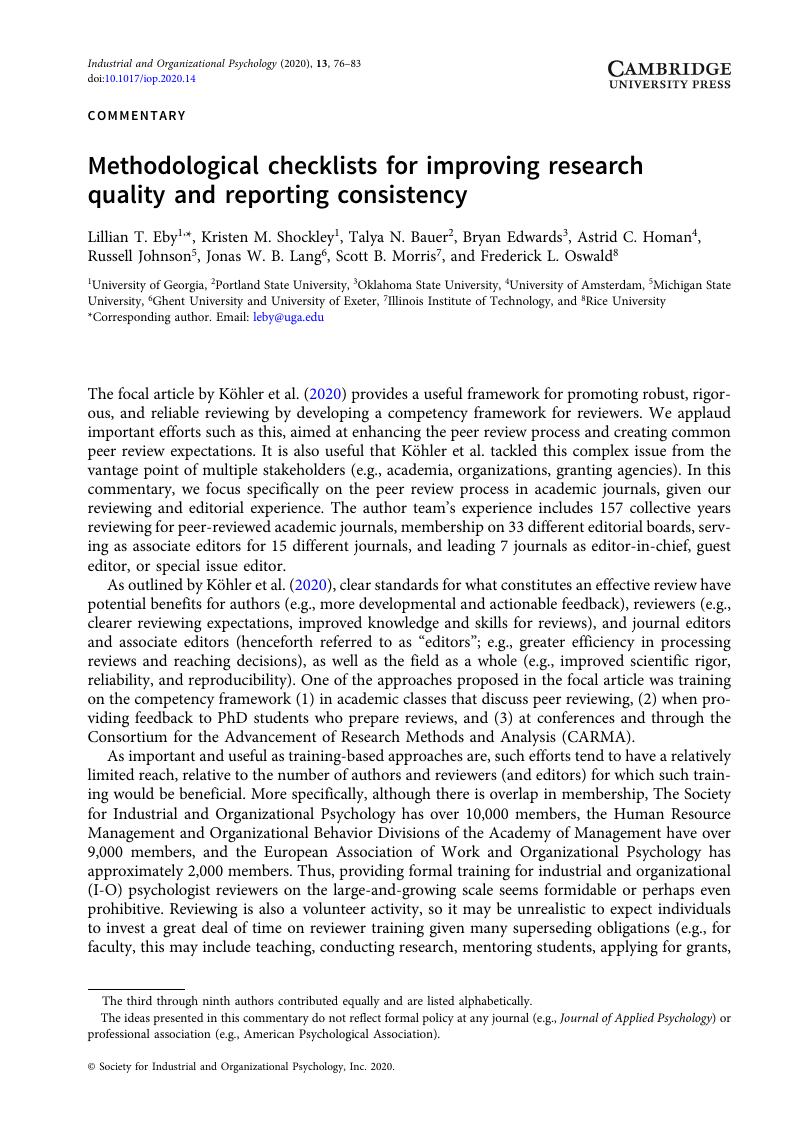Crossref Citations
This article has been cited by the following publications. This list is generated based on data provided by Crossref.
Lang, Jonas W. B.
2020.
Timely and to the Point.
Journal of Personnel Psychology,
Vol. 19,
Issue. 1,
p.
1.
Lang, Jonas WB
Runge, J Malte
and
De Fruyt, Filip
2021.
What are agile, flexible, or adaptable employees and students? A typology of dynamic individual differences in applied settings.
European Journal of Personality,
Vol. 35,
Issue. 4,
p.
510.
Barros, Miguel
and
Mesquita, Anabela
2021.
Advances in Tourism, Technology and Systems.
Vol. 209,
Issue. ,
p.
540.
Landoll, Ryan R
Vargas, Sara E
Samardzic, Kristen B
Clark, Madison F
and
Guastaferro, Kate
2022.
The preparation phase in the multiphase optimization strategy (MOST): a systematic review and introduction of a reporting checklist.
Translational Behavioral Medicine,
Vol. 12,
Issue. 2,
p.
291.
Castille, Christopher M.
Kreamer, Liana M.
Albritton, Betsy H.
Banks, George C.
and
Rogelberg, Steven G.
2022.
The Open Science Challenge: Adopt One Practice that Enacts Widely Shared Values.
Journal of Business and Psychology,
Vol. 37,
Issue. 3,
p.
459.
Kundro, Timothy G.
and
Rothbard, Nancy P.
2023.
Does Power Protect Female Moral Objectors? How and When Moral Objectors’ Gender, Power, and Use of Organizational Frames Influence Perceived Self-Control and Experienced Retaliation.
Academy of Management Journal,
Vol. 66,
Issue. 1,
p.
306.
Weiss, Matthias
Nair, Lakshmi B.
Hoorani, Bareerah H.
Gibbert, Michael
and
Hoegl, Martin
2023.
Transparency of reporting practices in quantitative field studies: The transparency sweet spot for article citations.
Journal of Informetrics,
Vol. 17,
Issue. 2,
p.
101396.
Ekhtiari, Hamed
Zare-Bidoky, Mehran
Sangchooli, Arshiya
Valyan, Alireza
Abi-Dargham, Anissa
Cannon, Dara M.
Carter, Cameron S.
Garavan, Hugh
George, Tony P.
Ghobadi-Azbari, Peyman
Juchem, Christoph
Krystal, John H.
Nichols, Thomas E.
Öngür, Dost
Pernet, Cyril R.
Poldrack, Russell A.
Thompson, Paul M.
and
Paulus, Martin P.
2024.
Reporting checklists in neuroimaging: promoting transparency, replicability, and reproducibility.
Neuropsychopharmacology,
Vol. 50,
Issue. 1,
p.
67.
Besomi, Manuela
Devecchi, Valter
Falla, Deborah
McGill, Kevin
Kiernan, Matthew C.
Merletti, Roberto
van Dieën, Jaap H.
Tucker, Kylie
Clancy, Edward A.
Søgaard, Karen
Hug, François
Carson, Richard G.
Perreault, Eric
Gandevia, Simon
Besier, Thor
Rothwell, John C.
Enoka, Roger M.
Holobar, Aleš
Disselhorst-Klug, Catherine
Wrigley, Tim
Lowery, Madeleine
Farina, Dario
and
Hodges, Paul W.
2024.
Consensus for experimental design in electromyography (CEDE) project: Checklist for reporting and critically appraising studies using EMG (CEDE-Check).
Journal of Electromyography and Kinesiology,
Vol. 76,
Issue. ,
p.
102874.



